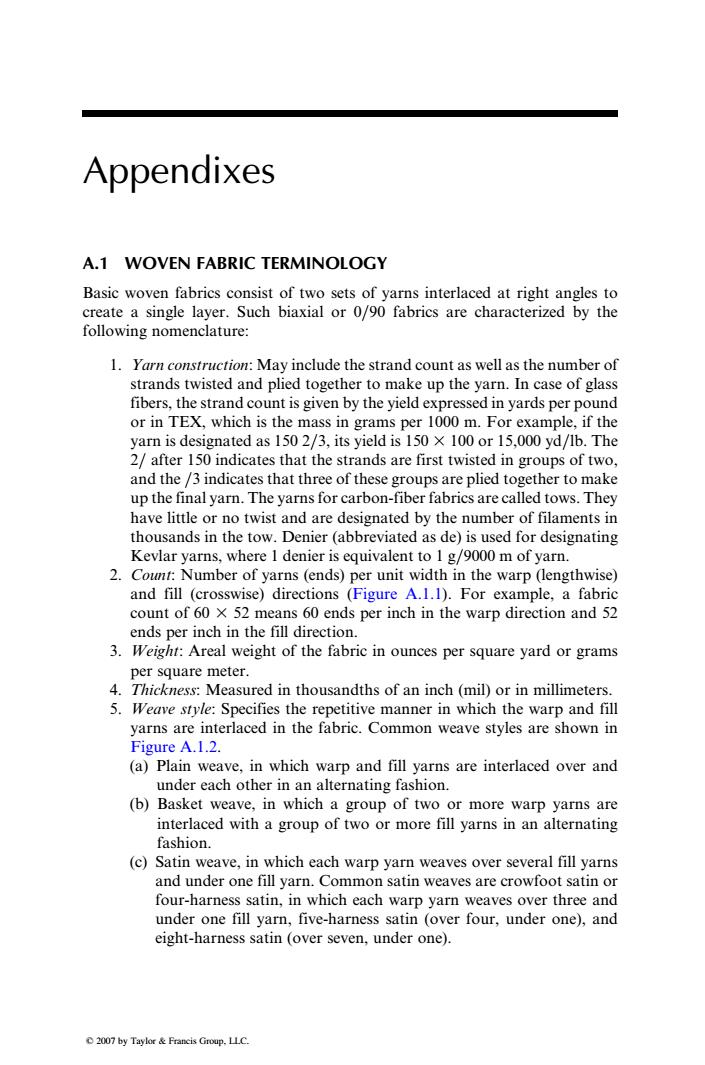正在加载图片...

Appendixes A.1 WOVEN FABRIC TERMINOLOGY Basic woven fabrics consist of two sets of yarns interlaced at right angles to create a single layer.Such biaxial or 0/90 fabrics are characterized by the following nomenclature: 1.Yarn construction:May include the strand count as well as the number of strands twisted and plied together to make up the yarn.In case of glass fibers,the strand count is given by the yield expressed in yards per pound or in TEX,which is the mass in grams per 1000 m.For example,if the yarn is designated as 150 2/3,its yield is 150 X 100 or 15,000 yd/lb.The 2/after 150 indicates that the strands are first twisted in groups of two, and the/3 indicates that three of these groups are plied together to make up the final yarn.The yarns for carbon-fiber fabrics are called tows.They have little or no twist and are designated by the number of filaments in thousands in the tow.Denier(abbreviated as de)is used for designating Kevlar yarns,where 1 denier is equivalent to 1 g/9000 m of yarn. 2.Count:Number of yarns (ends)per unit width in the warp (lengthwise) and fill (crosswise)directions (Figure A.1.1).For example,a fabric count of 60 X 52 means 60 ends per inch in the warp direction and 52 ends per inch in the fill direction. 3.Weight:Areal weight of the fabric in ounces per square yard or grams per square meter. 4.Thickness:Measured in thousandths of an inch (mil)or in millimeters. 5.Weave style:Specifies the repetitive manner in which the warp and fill yarns are interlaced in the fabric.Common weave styles are shown in Figure A.1.2. (a)Plain weave,in which warp and fill yarns are interlaced over and under each other in an alternating fashion. (b)Basket weave,in which a group of two or more warp yarns are interlaced with a group of two or more fill yarns in an alternating fashion. (c)Satin weave,in which each warp yarn weaves over several fill yarns and under one fill yarn.Common satin weaves are crowfoot satin or four-harness satin,in which each warp yarn weaves over three and under one fill yarn,five-harness satin (over four,under one),and eight-harness satin (over seven,under one). 2007 by Taylor&Francis Group.LLC.Appendixes A.1 WOVEN FABRIC TERMINOLOGY Basic woven fabrics consist of two sets of yarns interlaced at right angles to create a single layer. Such biaxial or 0=90 fabrics are characterized by the following nomenclature: 1. Yarn construction: May include the strand count as well as the number of strands twisted and plied together to make up the yarn. In case of glass fibers, the strand count is given by the yield expressed in yards per pound or in TEX, which is the mass in grams per 1000 m. For example, if the yarn is designated as 150 2=3, its yield is 150 3 100 or 15,000 yd=lb. The 2= after 150 indicates that the strands are first twisted in groups of two, and the =3 indicates that three of these groups are plied together to make up the final yarn. The yarns for carbon-fiber fabrics are called tows. They have little or no twist and are designated by the number of filaments in thousands in the tow. Denier (abbreviated as de) is used for designating Kevlar yarns, where 1 denier is equivalent to 1 g=9000 m of yarn. 2. Count: Number of yarns (ends) per unit width in the warp (lengthwise) and fill (crosswise) directions (Figure A.1.1). For example, a fabric count of 60 3 52 means 60 ends per inch in the warp direction and 52 ends per inch in the fill direction. 3. Weight: Areal weight of the fabric in ounces per square yard or grams per square meter. 4. Thickness: Measured in thousandths of an inch (mil) or in millimeters. 5. Weave style: Specifies the repetitive manner in which the warp and fill yarns are interlaced in the fabric. Common weave styles are shown in Figure A.1.2. (a) Plain weave, in which warp and fill yarns are interlaced over and under each other in an alternating fashion. (b) Basket weave, in which a group of two or more warp yarns are interlaced with a group of two or more fill yarns in an alternating fashion. (c) Satin weave, in which each warp yarn weaves over several fill yarns and under one fill yarn. Common satin weaves are crowfoot satin or four-harness satin, in which each warp yarn weaves over three and under one fill yarn, five-harness satin (over four, under one), and eight-harness satin (over seven, under one). 2007 by Taylor & Francis Group, LLC